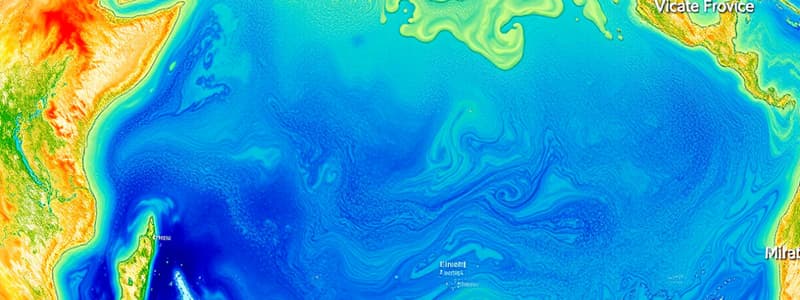Podcast
Questions and Answers
Which of the following is a consequence of increased Sea Surface Temperature?
Which of the following is a consequence of increased Sea Surface Temperature?
- Stabilization of fish breeding patterns.
- Decreased evaporation rates.
- Higher rates of coral bleaching. (correct)
- Reinforcement of ocean currents.
What is the primary function of measuring Sea Surface Temperature (SST)?
What is the primary function of measuring Sea Surface Temperature (SST)?
- To analyze fossil fuel emissions.
- To calculate weather balloon trajectories.
- To determine fish population density.
- To understand climate patterns and oceanic processes. (correct)
How does the Gulf Stream influence climate in regions it affects?
How does the Gulf Stream influence climate in regions it affects?
- By making cold regions warmer. (correct)
- By decreasing humidity levels.
- By generating hurricanes in the North Atlantic.
- By altering sea level rise rates.
What are El Niño and La Niña primarily associated with?
What are El Niño and La Niña primarily associated with?
Which of the following best describes a feedback mechanism related to rising Sea Surface Temperature?
Which of the following best describes a feedback mechanism related to rising Sea Surface Temperature?
What impact does Sea Surface Temperature have on human communities?
What impact does Sea Surface Temperature have on human communities?
Which technology is primarily used for monitoring Sea Surface Temperature?
Which technology is primarily used for monitoring Sea Surface Temperature?
What future consideration is critical for mitigating the impacts of changing Sea Surface Temperature?
What future consideration is critical for mitigating the impacts of changing Sea Surface Temperature?
Flashcards are hidden until you start studying
Study Notes
SST: The Changing Face of the Earth
-
Definition of SST:
- SST refers to Sea Surface Temperature, which is crucial in understanding climate patterns and oceanic processes.
-
Impact on Climate:
- SST influences weather patterns, including hurricanes and monsoons.
- Warmer SST can lead to increased evaporation, resulting in heavier precipitation.
-
Ocean Currents:
- Changes in SST affect ocean circulation, which redistributes heat across the globe.
- Important currents:
- Gulf Stream: Affects climate in North America and Europe.
- El Niño and La Niña: Phenomena linked to significant changes in global weather due to variations in SST.
-
Effects on Ecosystems:
- Coral reefs: Sensitive to temperature changes; bleaching occurs at elevated SSTs.
- Marine life: Species distribution and breeding patterns may change due to SST fluctuations.
-
Global Warming:
- Increased greenhouse gas emissions contribute to rising SSTs.
- Contributes to polar ice melt, sea level rise, and changing coastal landscapes.
-
Feedback Mechanisms:
- Melting ice reduces albedo, leading to further warming.
- Warmer oceans can absorb less CO2, impacting atmospheric carbon levels.
-
Human Impact:
- Coastal communities are affected by rising SSTs through increased flooding and erosion.
- Fisheries may suffer as species migrate or decline, affecting food security.
-
Monitoring SST:
- Use of satellite technology and buoys for accurate measurements.
- SST data informs climate models and weather forecasting.
-
Future Considerations:
- Importance of sustainable practices to mitigate climate change impacts.
- Need for ongoing research into the implications of changing SST on global ecosystems and human societies.
Sea Surface Temperature (SST)
- SST is essential for understanding climate variability and ocean dynamics.
- It directly influences global weather patterns, including the intensity and frequency of hurricanes and monsoons.
- Higher SSTs enhance evaporation rates, resulting in increased and heavier rainfall events.
Ocean Circulation
- Variations in SST dramatically impact ocean currents and heat distribution worldwide.
- The Gulf Stream plays a key role in moderating the climate of North America and Europe.
- El Niño and La Niña are significant phenomena driven by SST changes, causing considerable global weather fluctuations.
Ecosystem Effects
- Coral reefs are highly sensitive to temperature; higher SSTs lead to bleaching and increased mortality.
- Fluctuations in SST impact marine species distribution, influencing breeding habits and biodiversity.
Global Warming Contributions
- Rising SSTs are primarily a result of increased greenhouse gas emissions.
- Warmer seas contribute to the melting of polar ice, rising sea levels, and altered coastal communities.
Feedback Loops
- Melting ice lowers Earth's albedo, absorbing more heat and perpetuating warming.
- Warmer oceans exhibit a reduced capacity to absorb CO2, which affects global carbon levels and climate regulation.
Human Impacts
- Coastal regions face heightened risks from flooding and erosion caused by rising SSTs.
- Fisheries are threatened as marine species migrate or decline due to altered thermal conditions, impacting food security.
Monitoring Techniques
- Satellite technology and buoy systems are employed to track SST accurately.
- SST data is crucial for refining climate models and improving weather predictions.
Future Implications
- Sustainable practices are vital to minimize the adverse effects of climate change tied to SST increases.
- Ongoing research is necessary to understand the broader implications of changing SST on ecosystems and human activities globally.
Studying That Suits You
Use AI to generate personalized quizzes and flashcards to suit your learning preferences.




